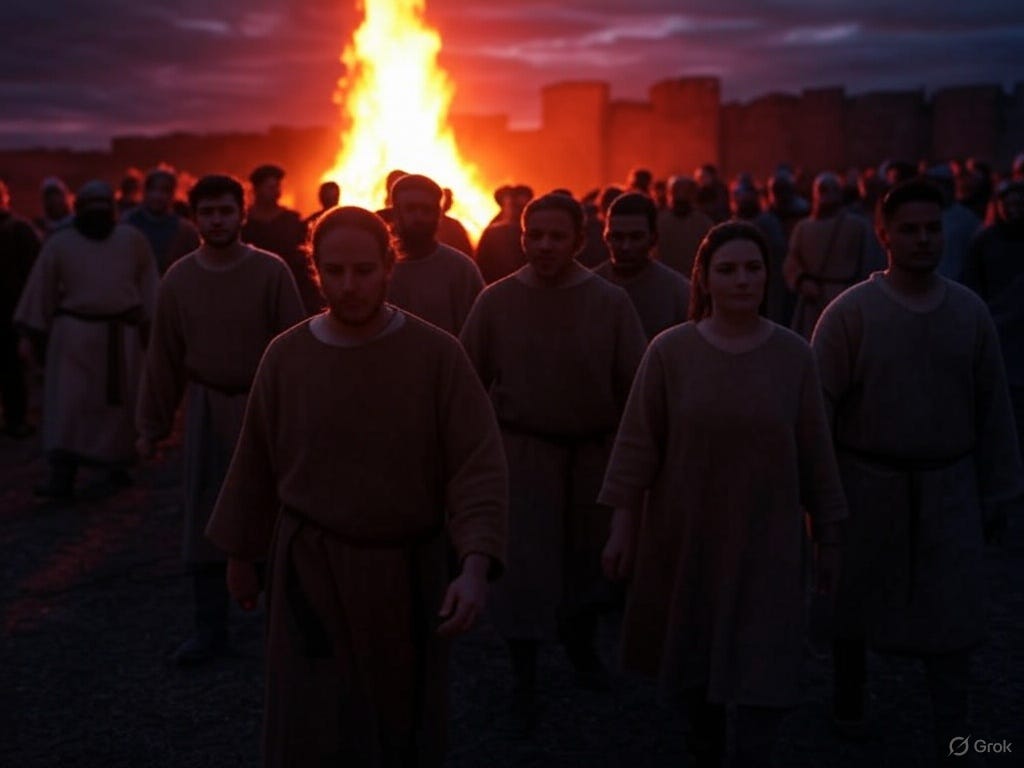The Daily Heretic publishes weekdays and Sundays at 8 am. We look at history’s rebels, radicals, and occasional bonfire enthusiasts.
This week’s series: The Cathars.
Next week: The Gnostics.
Stay curious. Stay heretical. And subscribe! 🔥
Simon de Montfort’s Ghost
Remember Simon de Montfort from Wednesday’s post? Before we dive into the fiery finale, let’s throw a rock at this one man siege engine. The original poster boy for “zealotry with extra violence,” de Montfort spearheaded the Albigensian Crusade’s early years, razing cities and earning nicknames like “the Scourge of the South.” By 1218, however, his luck ran out—literally. A well-aimed rock from a catapult (operated by, irony of ironies, Catholic defenders in Toulouse) crushed his skull. His legacy? A trail of ash and a son, Simon de Montfort the Younger, who inherited Dad’s bloodlust but none of his tactical genius.
While the elder de Montfort never saw Montségur, his specter loomed large. The crusader’s brutality set the tone: Convert or die.
The Siege of Montségur (1243–1244)
Perched like a eagle’s nest in the Pyrenees, Montségur was the Cathars’ final refuge—a place where Perfecti whispered prayers and probably practiced “mindfulness”. By 1243, the Church was done playing nice. An army of 10,000 crusaders surrounded the mountain, demanding surrender. The Cathars responded by throwing a rock. ( A clear shout out to the incident at Toulouse 👊 respect)
For 11 months, the siege dragged on. Crusaders camped in the valley, likely grumbling about the cold and being away from home for Christmas. The Cathars, meanwhile, survived on smuggled supplies and sheer spite. Legend claims they even sent a team of climbers down the cliffs at night to raid crusader camps.
As the end neared, the Cathars struck a deal: 15 days of truce. Why? Rumor says they smuggled out a “treasure”—not gold, but knowledge. Some say it was Gnostic texts; others insist it was the Holy Grail.
The Bonfire: A Final Act of Defiance
On March 16, 1244, the Cathars staged one of history’s most haunting acts of resistance. Over 200 Perfecti—men and women who had devoted their lives to spiritual purity—walked voluntarily into a massive pyre constructed at the base of Montségur. Eyewitness accounts describe them singing hymns, their voices rising above the crackle of flames, as they embraced a death they believed would liberate their souls from the “prison” of the material world. To the crusaders, it was a victory. To the Cathars, it was transcendence.
The crusaders, ever pragmatic (and perhaps eager to avoid paperwork), spared a handful of soldiers and townsfolk who renounced their Cathar beliefs. This wasn’t mercy—it was strategy. Survivors became walking advertisements for the Church’s “leniency,” though the message was clear: Convert or burn. As for the Perfecti, their ashes were no doubt scattered by the wind across the Pyrenees, becoming fertilizer for legends of martyrdom that would outlive the crusaders’ fleeting triumph.
Field Of The Burned
This wasn’t just execution—it was theater. The Church wanted a spectacle to terrify would-be heretics. Instead, they created an origin story for rebellion. The Perfecti’s calm acceptance of death, framed as spiritual victory, turned them into folk heroes. Even the crusaders’ chroniclers admitted it was “a thing of wonder… and horror.” The site of the pyre is now called the “Field of the Burned.”
The Cathars’ last stand became a rallying cry for later dissenters, from French Huguenots to goth teens in eyeliner. Crushing the Cathars didn’t end heresy—it just made martyrs.
The Cathars’ message? Question authority—preferably before it builds a siege engine.
The Sunday Heretic
This Sunday, we’ll recap the Cathars’ legacy: Why do we romanticize rebels who lost? Was their dualism genius or just medieval edgelord cosplay? And what’s with the Grail rumors? Join us for The Sunday Heretic—where history’s losers get the last laugh.
P.S. Simon de Montfort the Younger? He tried finishing Dad’s work but died less glamorously—dysentery. Poetic justice, or merely a flesh wound? You decide.
Stay curious. Stay heretical. And maybe avoid mountains with armies at the bottom. 🔥
This is 5 of 5 in a series on the Cathars - Series here: The Daily Heretic
Share with your friends so you can relive the excitement together!




